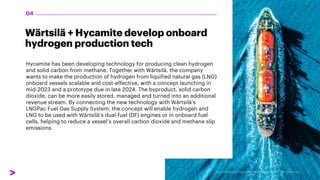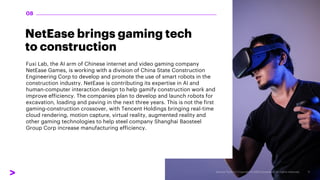The Industrialist: Trends & Innovations - March 2023
- 1. Innovate Trends and innovations that matter March 2023
- 2. Know more about the latest announcements impacting industry, from carbon capture at sea to the gaming tech transforming construction.
- 3. Industrial is a front runner in combining human ingenuity with technology and innovation. Thomas Rinn Managing Director, Global Industrial Sector Lead, Accenture
- 4. Hankook Tire saves emissions with restoration based on 3D printing Hankook Tire & Technology, Korea Atomic Energy Research Institute and startup HM3DP have developed a metal 3D printing technique to restore damaged parts. Damaged Parts Restoration Technology was adapted from an additive manufacturing process originally developed for nuclear reactor components. The technique has already been used to restore damaged titanium alloy blades in Hankook Tire production lines at its Daejeon plant. The costly blades are used to cut tire rubber materials containing hardening agents, and as they degrade over time they are typically discarded. By fixing and reusing the blades using a Directed Energy Deposition (DED) method, Hankook Tire has saved costs and reduced the amount of materials and energy typically used to build replacement blades, helping to reduce carbon emissions. 01
- 5. Hyundai Mobis + Ottopia scale remote autonomous vehicle support Hyundai Mobis and Ottopia are developing an end-to-end remote mobility assistance (RMA) platform to help commercialize autonomous vehicles across industries. The control tower solution is designed for both autonomous and automated vehicles and works in conjunction with human machine interfaces and 5G to scale the delivery of services such as teleoperation, remote diagnostics, Over-The-Air updates and fleet management. The platform will support everything from trucks and industrial vehicles to robotaxis and autonomous buses, harnessing Ottopia's core teleoperation technologies (including video, control, safety and cybersecurity) and Hyundai Mobis’ hardware, software and system integration capabilities. Ottopia’s staff in remote centers monitor, guide and even directly control vehicle fleets if needed, with the highly scalable platform designed to support the commercialization of autonomy across fields as diverse as transportation, logistics, construction, mining, agriculture and last mile delivery, helping those industries save on R&D costs and meet regulatory requirements. 02
- 6. MISC leads maritime carbon capture initiative MISC, ANDRITZ, Mitsui & Co and Samsung Heavy Industries (SHI) will together explore and develop opportunities related to carbon capture and storage (CSS) solutions in the maritime industry, designed to help customers achieve their ESG targets. The collaboration will be broken down into different focus areas between each party. MISC and Mitsui & Co will identify CCS hubs and evaluate the commercial and technical viability of different solutions; MISC and SHI will collaborate on the engineering, procurement and construction of floating carbon dioxide solutions to support offshore projects; and MISC and ANDRITZ will work on the application and optimization of carbon capture technologies and the execution of engineering, procurement, construction, installation, and commissioning of CCS systems at sea and on land. 03 REE
- 7. Wärtsilä + Hycamite develop onboard hydrogen production tech Hycamite has been developing technology for producing clean hydrogen and solid carbon from methane. Together with Wärtsilä, the company wants to make the production of hydrogen from liquified natural gas (LNG) onboard vessels scalable and cost-effective, with a concept launching in mid-2023 and a prototype due in late 2024. The byproduct, solid carbon dioxide, can be more easily stored, managed and turned into an additional revenue stream. By connecting the new technology with Wärtsilä’s LNGPac Fuel Gas Supply System, the concept will enable hydrogen and LNG to be used with Wärtsilä’s dual-fuel (DF) engines or in onboard fuel cells, helping to reduce a vessel’s overall carbon dioxide and methane slip emissions. 04
- 8. Hyundai Heavy Industries pioneers sustainable shipping tech Hyundai Heavy Industries (HHI) has commissioned a smart ship that can operate using either an onboard battery or LNG-fueled engine – or a combination of both. The 1,400-ton vessel features an electric propulsion system developed by Korea Shipbuilding & Marine Engineering, with a unique energy storage system that enables hybrid power to be used. It reduced emissions by 40% in trials and can operate at speeds of up to 16 knots. HHI says its electric propulsion system also improved fuel efficiency by 6% thanks to engine control optimization, with the technology winning the CES 2023 Innovation Award from the Consumer Technology Association. The latest innovation is just one step in HHI’s pledge to operate zero carbon vessels by 2050. The company is also looking at adjusting ship shapes to reduce wind resistance and improving shipping traffic visibility and port infrastructure to reduce delays. Its ISS 2.0 smart ship platform aims to collect data and better track vessels to optimize routes, reducing wait times and saving fuel. The company estimates its technology can increase global shipping capacity by 10%. 05
- 9. Zoomlion pioneers intelligent, autonomous construction solution Zoomlion’s solution in Hunan includes a fleet of 11 pieces of equipment that can fully coordinate unmanned construction, spanning everything from excavation and concrete pumping to hoisting and installation. The system is made up of an iCES intelligent scheduling system that can resolve Building Information Modeling (BIM) tasks in milliseconds with 100 percent accuracy and reduce waiting times by 28%; a MAS multi- intelligent equipment cooperation system that can coordinate intelligent equipment to improve collaboration and prevent collisions; and a 4DT digital twin for site monitoring and better management that enables intelligent decision-making to reduce construction time by 30%. Together, these elements enable the system to fully coordinate end-to-end construction tasks autonomously. 06
- 10. Epiroc and Roy Hill ramp up world’s largest autonomous mine Epiroc will support Roy Hill in the final stages of a project to create the world's largest autonomous mine. The companies, along with automation firm ASI Mining, have collaborated for the past two years on developing an autonomous, interoperable and scalable haul truck solution that can be used with any vehicle brand. To date, the companies have converted 10 trucks into driverless vehicles using ASI Mining's Mobius systems, enabling them to navigate and communicate with other vehicles and a remote operations center in Perth. The fleet runs 24/7, interacts with other vehicles, has recorded higher productivity rates and meets all safety standards. Roy Hill aims to have 54 Caterpillar trucks and 42 Hitachi trucks converted and communicating with 200 other vehicles later in 2023. 07
- 11. NetEase brings gaming tech to construction Fuxi Lab, the AI arm of Chinese internet and video gaming company NetEase Games, is working with a division of China State Construction Engineering Corp to develop and promote the use of smart robots in the construction industry. NetEase is contributing its expertise in AI and human-computer interaction design to help gamify construction work and improve efficiency. The companies plan to develop and launch robots for excavation, loading and paving in the next three years. This is not the first gaming-construction crossover, with Tencent Holdings bringing real-time cloud rendering, motion capture, virtual reality, augmented reality and other gaming technologies to help steel company Shanghai Baosteel Group Corp increase manufacturing efficiency. 08
- 12. About The Industrialist The Industrialist is our monthly digital magazine that puts game- changing perspectives in the spotlight. It combines thought- provoking content and insights, to keep you on top of what’s new in the industrial industry. Featuring different CXOs and diverse leader views, you can be inspired by leading innovators, explore the latest trends, tools, technologies, and innovations, and ignite your industry interest with transformational thought leadership. Discover how to lead the way and Subscribe today. Visit us at www.accenture.com/theindustrialist Disclaimer This document makes reference to names, marks, and domains/websites owned by third parties. All such names, marks, and domains/websites are the property of their respective owners. No sponsorship, endorsement or approval of this content by the owners of such materials is intended, expressed or implied. Copyright © 2023 Accenture all rights reserved.











